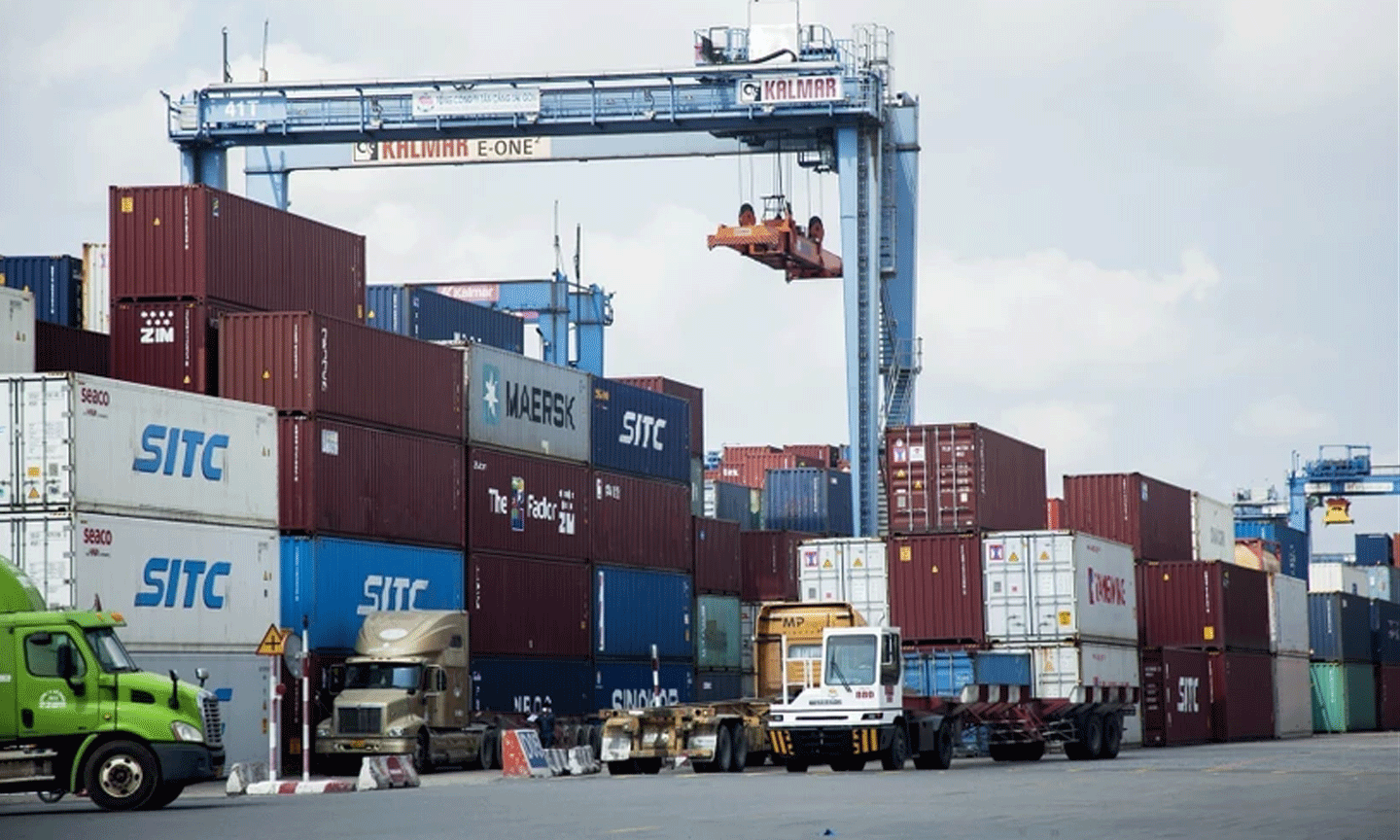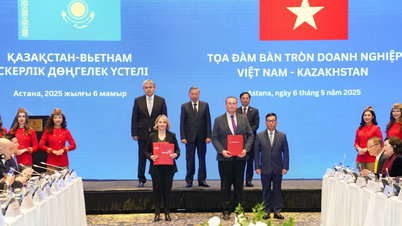 |
The US tax hike requires the Government to make more responsive, proactive and timely policy decisions. (Photo: Vietnam+) |
On the afternoon of April 2, local time, US President Donald Trump announced plans to impose a 46% reciprocal tax on 90% of total imported goods from Vietnam, the second highest among countries exporting to the US market, after Cambodia (a 49% tax on 97% of total exported goods to the US).
According to Dr. Can Van Luc and the group of authors from BIDV Training and Research Institute, in addition to the impact on exports and growth, the US tax increase policy also causes prices to increase, inflationary pressure and exchange rates to increase, the domestic stock market and currency will fluctuate more (as many other countries are facing). This requires the Government's policy management decisions to be more responsive, proactive and timely.
Mr. Luc emphasized that Vietnam is the 8th largest trading partner of the US (total two-way turnover in 2024 is 149.7 billion USD and accounts for 2.8% of the total value of US goods trade). Vietnam also ranks 6th in exports to the US (136.6 billion USD, accounting for 4.2% of total US imports). Accordingly, Vietnam ranks 3rd in trade surplus with the US (123.5 billion USD).
With the above move, the US Government clearly shows its view that international trade must be more balanced and fair. However, Mr. Luc shared that negotiations can still be held until April 9, but Vietnam also needs to have scenarios for different tax rates.
In addition, Mr. Luc pointed out that the impacts of the US tax policy will greatly affect 5 key sectors of Vietnam. Specifically, in the 5 main industries (accounting for 64.3% of total export turnover to the US in 2024), electronics (computers, electronic products and components; phones of all kinds and components; cameras, camcorders and components) account for 28.6% of total export turnover to the US; Textiles, footwear and leather account for 21.9%; Wood and wood products account for 7.6%; Agriculture, aquaculture and seafood account for 3.5%; Steel and aluminum account for 2.7%.
Currently, the electronics industry is limited by its large scale of production and investment, high technology, and heavy dependence on FDI enterprises. Therefore, the new tax rate may negatively impact investment decisions for semiconductor manufacturing projects in Vietnam in the future.
The textile, garment and footwear industry will be strongly affected by high international competition pressure, easier ability to shift production chains and high price sensitivity. The imposition of higher tariffs in the US market will cause the industry to face many challenges when costs and export barriers increase. Moreover, this is a product that can be used for a long time, has high price sensitivity when prices increase combined with economic difficulties and uncertainties.
The wood and wood products industry will be moderately impacted due to the relatively stable supply chain and high demand in the US. However, domestic businesses should also note that these are durable goods with high price sensitivity (such as textiles, footwear), so when the economy is difficult, consumers tend to save, which may reduce purchasing power.
Especially in the agricultural-aquatic-seafood sector, in 2024, the US will be Vietnam's largest agricultural-aquatic export market with a value of 4.16 billion USD, accounting for 3.5% of total export turnover to this market. It is forecasted that Vietnam's seafood exports to the US in 2025 could reach more than 2 billion USD, an increase of 10-12% over the previous year. With a tax rate of 46%, Vietnamese seafood products entering the US may have to pay an additional amount of 0.92 billion USD in 2025.
In fact, agricultural products exported to the US market will grow positively in 2024. These items only account for about 1.6% of the total import value of US goods in 2024. It is forecasted that Vietnam's agricultural exports to the US in 2025 will reach 2.7-2.8 billion USD, an increase of 15-20% compared to the previous year. At that time, the tax rate that the industry may have to pay is nearly 1.28 billion USD in 2025.
The steel and aluminum industry recorded that in 2024, Vietnam exported 1.32 billion USD of various types of iron and steel to the US (accounting for about 4% of the industry's total production value). In addition, Vietnam exported about 479 million USD of aluminum and aluminum products to the US market. With the decision to impose new taxes, Vietnam's aluminum exports to the US were negatively affected when the tax was increased to the above level.
Accordingly, Mr. Luc recommended that Vietnam should pay more attention to measures to promote mutually beneficial cooperation with the US in many fields, strengthen foreign channels, and steadfastly diversify markets, partners, and products; and make better use of the 17 signed FTAs.
In addition, Vietnam is considering implementing a number of measures to balance trade more in the direction of open exchanges with the US on measures to help balance the trade balance; proactively considering reducing reciprocal taxes as mentioned above and increasing imports from the US, especially products that the US has strengths in and Vietnam has demand for. In the long term, Vietnam can consider negotiating and signing an FTA with the US.
In addition, relevant ministries and sectors need to develop specific groups of solutions for key export sectors and fields, especially the five fields mentioned above, to limit the decline and focus on strengthening internal strength, autonomy, self-reliance and connectivity between business sectors (domestic and FDI) and between businesses in the value chain to ensure increased adaptability, stable and sustainable development. Furthermore, ministries, sectors and industry associations need to proactively work with partners in the US and related countries, provide information, orientation, advice and collect recommendations and problems of businesses. From there, the parties will quickly discuss and have appropriate, timely and effective solutions to those difficulties and problems...
For the business community, Mr. Luc said that it is necessary to be proactive and coordinate with State management agencies, Vietnamese trade offices abroad, embassies, international organizations, and importers to grasp the situation and information, market developments, thereby having timely and appropriate response measures. In particular, businesses need to diversify markets, partners, supply chains, and take advantage of signed trade agreements (FTAs), targeting large, potential markets (such as the Halal market with a scale of 2.2 billion people), African and South American markets, etc. Businesses need to increase the application of information technology and circular business to take advantage of waste materials, reduce costs, and reduce prices to be able to share part of the increased tax costs with partners./.
According to Vietnam+ (Vietnam News Agency)
Source: https://baoapbac.vn/kinh-te/202504/can-chuan-bi-cac-kich-ban-khac-nhau-truoc-ky-han-dam-phan-thue-voi-my-ngay-94-1038675/


![[Photo] Prime Minister Pham Minh Chinh chairs the regular Government meeting in April 2025](https://vphoto.vietnam.vn/thumb/1200x675/vietnam/resource/IMAGE/2025/5/6/48eb0c5318914cc49ff858e81c924e65)
![[Photo] Prime Minister Pham Minh Chinh receives Mr. Tomas Heidar, Chief Justice of the International Tribunal for the Law of the Sea (ITLOS)](https://vphoto.vietnam.vn/thumb/1200x675/vietnam/resource/IMAGE/2025/5/6/58ba7a6773444e17bd987187397e4a1b)



![[Photo] Prime Minister Pham Minh Chinh chairs meeting to review preparations for trade negotiations with the United States](https://vphoto.vietnam.vn/thumb/1200x675/vietnam/resource/IMAGE/2025/5/6/1edc3a9bab5e48db95318758f019b99b)

















































































Comment (0)